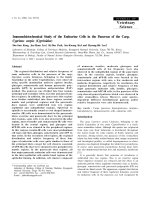Physiology: The endocrine glands
Bạn đang xem bản rút gọn của tài liệu. Xem và tải ngay bản đầy đủ của tài liệu tại đây (1.43 MB, 59 trang )
Physiology
Endocrine Glands:
Secretion and Action of
Hormones
www.cambodiamed.com
www.cambodiamed.com
Endocrine Glands and Hormones
Secrete biologically
active molecules into
the blood.
◦ Lack ducts.
Carry hormones to
target cells that contain
specific receptor
proteins for that
hormone.
Target cells can
respond in a specific
fashion.
www.cambodiamed.com
Endocrine Glands and Hormones
(continued)
• Neurohormone:
• Specialized neurons that secrete chemicals into the
blood rather than synaptic cleft.
• Chemical secreted is called neurohormone.
• Hormones:
• Affect metabolism of target organs.
• Help regulate total body metabolism, growth, and
reproduction.
www.cambodiamed.com
Chemical Classification of
Hormones
• Amines:
• Hormones derived from tyrosine and tryptophan.
• NE, Epi, T4.
• Polypeptides and proteins:
• Polypeptides:
• Chains of < 100 amino acids in length.
• ADH.
• Protein hormones:
• Polypeptide chains with > 100 amino acids.
• Growth hormone.
www.cambodiamed.com
Chemical Classification of
Hormones
(continued)
• Lipids derived from cholesterol.
• Are lipophilic hormones.
•
•
•
•
Testosterone.
Estradiol.
Cortisol.
Progesterone.
www.cambodiamed.com
Chemical Classification of
Hormones
(continued)
www.cambodiamed.com
Chemical Classification of Hormones
(continued)
Glycoproteins:
◦ Long polypeptides (>100) bound to 1 or more carbohydrate
(CHO) groups.
FSH and LH.
Hormones can also be divided into:
◦ Polar:
H20 soluble.
◦ Nonpolar (lipophilic):
H20 insoluble.
Can gain entry into target cells.
Steroid hormones and T4.
◦ Pineal gland secretes melatonin:
Has properties of both H20 soluble and lipophilic hormones.
www.cambodiamed.com
Prohormones and Prehormones
• Prohormone:
• Precursor is a longer chained polypeptide that is cut
and spliced together to make the hormone.
• Proinsulin.
• Preprohormone:
• Prohormone derived from larger precursor molecule.
• Preproinsulin.
• Prehormone:
• Molecules secreted by endocrine glands that are
inactive until changed into hormones by target cells.
• T4 converted to T3.
www.cambodiamed.com
Common Aspects of Neural and Endocrine
Regulation
• APs are chemical events produced by diffusion of ions through
neuron plasma membrane.
• Action of some hormones are accompanied by ion diffusion
and electrical changes in the target cell.
▫ Nerve axon boutons release NTs.
▫ Some chemicals are secreted as hormones, and also are NTs.
• In order for either a NT or hormone to function in physiological
regulation:
▫ Target cell must have specific receptor proteins.
▫ Combination of the regulatory molecule with its receptor proteins
must cause a specific sequence of changes.
▫ There must be a mechanism to quickly turn off the action of a
regulator.
www.cambodiamed.com
Hormonal Interactions
• Synergistic:
• Two hormones work together to produce a result.
• Additive:
• Each hormone separately produces response, together at
same concentrations stimulate even greater effect.
• NE and Epi.
• Complementary:
• Each hormone stimulates different step in the process.
• FSH and testosterone.
www.cambodiamed.com
www.cambodiamed.com
Hormonal Interactions
(continued)
• Permissive effects:
• Hormone enhances the responsiveness of a target organ to
second hormone.
• Increases the activity of a second hormone.
• Prior exposure of uterus to estrogen induces formation of
receptors for progesterone.
• Antagonistic effects:
• Action of one hormone antagonizes the effects of another.
• Insulin and glucagon.
www.cambodiamed.com
Effects of [Hormone] on Tissue
Response
• [Hormone] in blood reflects the rate of secretion.
• Half-life:
• Time required for the blood [hormone] to be reduced to
½ reference level.
• Minutes to days.
• Normal tissue responses are produced only when
[hormone] are present within physiological range.
• Varying [hormone] within normal, physiological
range can affect the responsiveness of target cells.
www.cambodiamed.com
Effects of [Hormone] on Tissue
Response
(continued)
• Priming effect (upregulation):
• Increase number of receptors formed on target cells in
response to particular hormone.
• Greater response by the target cell.
• Desensitization (downregulation):
• Prolonged exposure to high [polypeptide hormone].
• Subsequent exposure to the same [hormone] produces less
response.
• Decrease in number of receptors on target cells.
• Insulin in adipose cells.
• Pulsatile secretion may prevent downregulation.
www.cambodiamed.com
Mechanisms of Hormone Action
• Hormones of same chemical class have similar
mechanisms of action.
• Similarities include:
• Location of cellular receptor proteins depends on the chemical
nature of the hormone.
• Events that occur in the target cells.
• To respond to a hormone:
• Target cell must have specific receptors for that
hormone (specificity).
• Hormones exhibit:
• Affinity (bind to receptors with high bond strength).
• Saturation (low capacity of receptors).
www.cambodiamed.com
Hormones That Bind to Nuclear
Receptor Proteins
• Lipophilic steroid and
thyroid hormones are
attached to plasma
carrier proteins.
▫ Hormones dissociate from
carrier proteins to pass
through lipid component of
the target plasma
membrane.
• Receptors for the
lipophilic hormones are
known as nuclear
hormone receptors.
www.cambodiamed.com
Nuclear Hormone Receptors
• Steroid receptors are located in cytoplasm and in the
nucleus.
• Function within cell to activate genetic transcription.
• Messenger RNA directs synthesis of specific enzyme proteins that
change metabolism.
• Each nuclear hormone receptor has 2 regions:
• A ligand (hormone)-binding domain.
• DNA-binding domain.
• Receptor must be activated by binding to hormone before
binding to specific region of DNA called HRE (hormone
responsive element).
• Located adjacent to gene that will be transcribed.
www.cambodiamed.com
Mechanisms of Steroid Hormone
Action
• Cytoplasmic receptor
binds to steroid hormone.
• Translocates to nucleus.
• DNA-binding domain
binds to specific HRE of
the DNA.
• Dimerization occurs.
▫ Process of 2 receptor units
coming together at the 2
half-sites.
• Stimulates transcription
of particular genes.
www.cambodiamed.com
Mechanism of Thyroid Hormone Action
• T4 passes into cytoplasm and is
converted to T3.
• Receptor proteins located in
nucleus.
▫ T3 binds to ligand-binding
domain.
▫ Other half-site is vitamin A
derivative (9-cis-retinoic) acid.
DNA-binding domain can then
bind to the half-site of the HRE.
▫ Two partners can bind to the
DNA to activate HRE.
Stimulate transcription of genes.
www.cambodiamed.com
Hormones That Use 2nd Messengers
• Hormones cannot pass through plasma
membrane use 2nd messengers.
• Catecholamine, polypeptide, and glycoprotein
hormones bind to receptor proteins on the target
plasma membrane.
• Actions are mediated by 2nd messengers
(signal-transduction mechanisms).
• Extracellular hormones are transduced into
intracellular 2nd messengers.
www.cambodiamed.com
Adenylate Cyclase-cAMP
• Polypeptide or glycoprotein hormone binds to
receptor protein causing dissociation of a subunit
of G-protein.
• G-protein subunit binds to and activates
adenylate cyclase.
• ATP
cAMP + PPi
• cAMP attaches to inhibitory subunit of protein
kinase.
• Inhibitory subunit dissociates and activates protein
kinase.
www.cambodiamed.com
Adenylate Cyclase-cAMP
• Phosphorylates enzymes
within the cell to
produce hormone’s
effects.
• Modulates activity of
enzymes present in the
cell.
• Alters metabolism of the
cell.
• cAMP inactivated by
phosphodiesterase.
• Hydrolyzes cAMP to
inactive fragments.
www.cambodiamed.com
(continued)
Phospholipase-C-Ca2+
• Binding of Epi to a-adrenergic receptor in plasma
membrane activates a G-protein intermediate,
phospholipase C.
• Phospholipase C splits phospholipid into IP3 and DAG.
• Both derivatives serve as 2nd messengers.
• IP3 diffuses through cytoplasm to ER.
• Binding of IP3 to receptor protein in ER causes Ca2+
channels to open.
www.cambodiamed.com
Phospholipase-C-Ca2+
• Ca2+ diffuses into
the cytoplasm.
• Ca2+ binds to
calmodulin.
• Calmodulin
activates specific
protein kinase
enzymes.
• Alters the
metabolism of the
cell, producing the
hormone’s effects.
www.cambodiamed.com
(continued)
Epi Can Act Through Two 2nd
Messenger Systems
www.cambodiamed.com
Tyrosine Kinase
• Insulin receptor consists of 2 units that dimerize when
they bind with insulin.
• Insulin binds to ligand–binding site on plasma membrane,
activating enzymatic site in the cytoplasm.
• Autophosphorylation occurs, increasing tyrosine kinase
activity.
• Activates signaling molecules.
• Stimulate glycogen, fat and protein synthesis.
• Stimulate insertion of GLUT-4 carrier proteins.
www.cambodiamed.com









